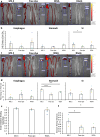Identification and Validation of Cyclic Peptides with Mucin-Selective, Location-Specific Binding in the Gastrointestinal Tract
- PMID: 40216380
- PMCID: PMC12020424
- DOI: 10.1021/acsnano.4c13520
Identification and Validation of Cyclic Peptides with Mucin-Selective, Location-Specific Binding in the Gastrointestinal Tract
Abstract
Oral drug delivery is a widely preferred method of drug administration due to its ease of use and convenience for patients. Localization of drug release in the gastrointestinal (GI) tract is important to treat localized diseases and maximize drug absorption. However, achieving drug localization in the dynamic GI tract is challenging. To address this challenge, we leveraged the geographic diversity of the GI tract by targeting its mucus layers, which coat the epithelial surfaces. These layers, composed of mucin glycoproteins, are synthesized with unique chemical compositions and expressed in different regions, making them ideal targets for drug localization. In this article, we identify cyclic peptides that bind selectively to MUC2 (in the intestines) and MUC5AC (in the stomach), serving as targeting ligands to these regions of the GI tract. We demonstrate the effectiveness of these peptides through in vitro, ex vivo, and in vivo experiments, showing that incorporating these targeting ligands can increase binding and selectivity 2-fold to the desired regions, thus potentially overcoming challenges with localizing drug distribution in oral delivery. These results indicate that cyclic peptides can be used to localize drug cargoes at certain sites in the body compared to free drugs.
Keywords: binding; gastrointestinal; localization; mucin; peptide; specificity.
Conflict of interest statement
The authors declare no competing financial interest.
Figures




References
-
- Lehr C.-M.; Poelma F. G. J.; Junginger H. E.; Tukker J. J. An estimate of turnover time of intestinal mucus gel layer in the rat in situ loop. Int. J. Pharm. 1991, 70 (3), 235–240. 10.1016/0378-5173(91)90287-X. - DOI
- Corfield A. P.; Carroll D.; Myerscough N.; Probert C. S. Mucins in the gastrointestinal tract in health and disease. Front Biosci. 2001, 6 (1), D1321–1357. 10.2741/corfield. - DOI - PubMed
Publication types
MeSH terms
Substances
Grants and funding
LinkOut - more resources
Full Text Sources
Miscellaneous

